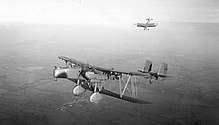Handley Page Heyford
| Handley Page HP50 Heyford | |
|---|---|
 Handley Page HP50 Heyford |
|
| Type: | Double Decker - Bomber |
| Design country: | |
| Manufacturer: | |
| First flight: |
June 21, 1933 |
| Commissioning: |
1934 |
| Production time: |
1933 to 1936 |
| Number of pieces: |
125 |
The Handley Page HP50 Heyford was a twin-engine heavy night bomber of the Royal Air Force (RAF) and at the same time the last British biplane bomber. It was developed by Handley Page in the 1930s. The first flight was in 1933. The type was only used for a short period of time (until 1937), but several RAF squadrons were equipped with it. The last Heyford were not taken out of service as training aircraft until 1941.
history
The Handley Page Heyford was built to the same specifications as the monoplane bomber Fairey Hendon . The prototype - the Handley Page HP38, which first flew on June 12, 1930 from the Handley Page factory airfield in Radlett - was designed by Handley Page chief designer GR Volkert. The Heyford's maiden flight took place on June 21, 1933.
A total of eleven different squadrons were equipped with the Heyford by 1941. But the use as a bomber ended already in 1937. The remaining machines were then to training for bombing and gunnery used. Some machines were used for radar and air refueling tests. In 1941 the Heyford disappeared from the Royal Air Force for good .
In December 1936 seven Heyfords of 102nd Squadron flew to their base in Northern Ireland . In thick fog and freezing temperatures, three machines crashed and three more were damaged in hard landings. Three crew members died.
construction
The fuselage consisted of a composite of plywood and duralumin . The bomb bay was in the reinforced center of the lower wing . The landing gear was rigid and covered. The design allowed the ground crew to load the bomb bays while the engines were running. The pilot sat five meters above the ground.
variants
- Mk I, 15 pieces, two Rolls-Royce Kestrel III engines with 575 hp and two-bladed propellers
- Mk IA, 23 pieces, four-blade propellers, engine modifications and wind-powered generators
- Mk II, 16 pieces with Kestrel IV engines (640 HP)
- MK III, 70 pieces with Kestrel VI engines (695 hp)
A total of 125 machines were built with the prototype.
Production numbers
| year | 1933 | 1934 | 1935 | 1936 | total |
|---|---|---|---|---|---|
| Mk I | 3 | 11 | 14th | ||
| Mk IA | 23 | 23 | |||
| Mk II | 1 | 16 | 17th | ||
| Mk III | 20th | 50 | 70 | ||
| total | 3 | 35 | 36 | 50 | 124 |
Military use
Technical specifications
| Parameter | Data |
|---|---|
| crew | 4th |
| length | 17.68 m |
| span | 22.86 m |
| Wing area | 136.5 m² |
| height | 5.33 m |
| Empty mass | 4572 kg |
| Takeoff mass | 7587 kg |
| drive | 2 × Rolls-Royce Kestrel III-S or III-S5, 575 PS (423 kW) |
| Top speed | 228 km / h |
| Service ceiling | 6400 m |
| Range | 1480 km |
| Armament | 3 × 7.7 mm Lewis machine guns, 8 × 9 kg bombs and 1,132 kg bombs in the bomb bay |
Comparable types
See also
Web links
- "The Handley Page Heyford", Part 1, Flight , Issue v. July 6, 1933, page 666 ff. , Available online at flightglobal.com - Aviation History - PDF archive, in English - accessed on May 14, 2015
- "The Handley Page Heyford", Part 2, Flight , Issue v. July 20, 1933, page 718 ff. , Available online at flightglobal.com - Aviation History - PDF archive, in English - accessed on May 14, 2015
- Handley Page HP50 Heyford in the Virtual Aircraft Museum , accessed May 14, 2015
Individual evidence
- ↑ Air Britain: Aeromilitaria 1994/1, p. 3 ff.
